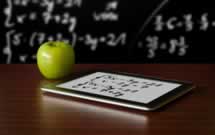Elementary, middle school students could develop better research and critical thinking skills
Students are comfortable using technology, but they often lack important research and information literacy skills, according to a new survey that aims to gauge students’ skills in areas critical to college and workplace success.
Statistics from previous surveys indicate that U.S. students may not be well-equipped to compete with their peers from other countries.
In fact, The College Board’s 2013 SAT Report on College and Career Readiness [1] indicates that 57 percent of high school grads do not meet the college- and career-readiness benchmark.
(Next page: How students performed)Learning.com administered its 21st Century Skills Assessment [2], which aligns to ISTE’s Standards for Students, to 101,797 elementary and 433,392 middle school students over a three-year period. The results are displayed in an infographic [3] highlighting some of the survey’s main points.
The survey reveals weaknesses in research and information fluency, as well as critical thinking and problem solving.
Just 34 percent of elementary students surveyed can process data and report results, and only 38 percent can plan strategies to guide inquiry.
Thirty-three percent of middle school students are able to collect and analyze data in order to identify solutions and make informed decisions, and 46 percent can process data and report results.
Students did demonstrate strengths in digital citizenship and technology operations and concepts.
Seventy-three percent of elementary school students express a positive attitude toward using technology that supports learning, and 64 percent exhibit leadership in digital citizenship.
Seventy-two percent of middle school students use information and technology in safe, legal, and responsible ways. Sixty-six percent demonstrate personal responsibility for lifelong learning.
On a scale of 0-500, with 500 a perfect and “advanced” score level, 50 percent of elementary schoolers scored at a “basic” or “below basic” level, and the average score was 303. The average middle school score was 284, and 60 percent of middle schoolers scored “basic” or below.
Teaching strategies that can help educators and students use and incorporate 21st century skills into everyday teaching and learning include:
- Using digital tools for research and communication
- Promoting safe online behavior
- Encouraging collaboration among students
- Integrating technology into core instruction
- Fostering creativity in the classroom
- Implementing project-based learning
(Next page: The survey infographic)
